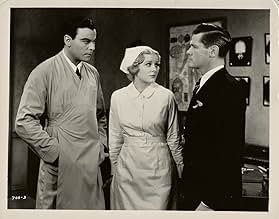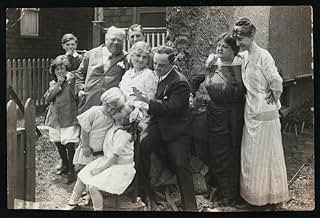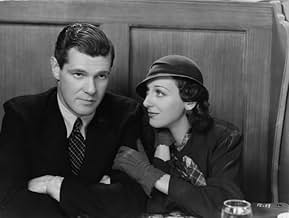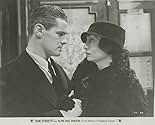Paul Kelly(1899-1956)
- Actor
- Writer
- Soundtrack
Lean, red/auburn-haired, athletically-inclined Paul Michael Kelly grew up on the tough streets of Brooklyn, New York. Born August 9, 1899, the ninth of ten children in a Roman Catholic family of Irish descent. The siblings' father, Michael, owned a bar called Kelly's Cafe. He died while Paul was still quite young and the entire clan was required to pitch in financially. Young Paul, who wound up making his Broadway debut at age 8 in "The Grand Army Man", did quite well for his family. His father's establishment was located close to Vitagraph Studios and the studio used to borrow furniture from the saloon for their sets. As partial repayment (at the request of his mother), the studio would use Paul for some of their one-reel silent films.
From 1911 on, he was the resident moppet at the studio,known as 'Chick Kelly, the Vitagraph Boy'. He appeared with such top matinée heavyweights as Maurice Costello and Constance Talmadge. The good-looking Kelly played the son in "The Jarr Family" series of one-reel adventures starring Harry Davenport as the patriarch. He transitioned into teen and young adult roles alternating between theater and movie assignments. Hit Broadway shows included "Little Women" (1916), Booth Tarkington's "Seventeen" (1918), and the highly popular "Penrod" starring Helen Hayes (also 1918). On celluloid he was romantically paired with Mary Miles Minter in the silent classic Anne of Green Gables (1919) and the success of that film moved him into even higher contention. The early 20s continued to be fruitful for Paul especially behind the theater footlights where he joined such esteemed leading ladies as Doris Kenyon in "Up the Ladder" (1922) and Blanche Yurka in "The Sea Woman" (1925). Films beckoned with The Great Adventure (1921), The New Klondike (1926), Slide, Kelly, Slide (1927) and Special Delivery (1927).
It was the love of a woman in the form of actress Dorothy Mackaye, however, that temporarily proved his undoing. Kelly met Dorothy Mackaye and her husband, Ziegfeld Follies song-and-dance man Ray Raymond (1888-1927), in New York and the three became fast friends and party-hearty cronies. They reconnected again years later when all had moved to Hollywood to pursue film. Her shaky marriage led her and Paul into a torrid love affair. By April 16, 1927, the couple's cover had been blown wide open. That same day, the two men, both drunk, duked it out. Ray came out the definite loser in the fight. Ethel Lee, the Raymonds' maid, opened the door and Kelly stormed into the house and confronted the much smaller man. Kelly shouted: "I understand that you have been saying things about me." Ray denied the accusation and attempted to defuse the situation by offering Kelly a seat, but Kelly, 6 feet tall and weighed about 200 lbs, was drunk and spoiling for a fight. According to the maid, Ray told Kelly: "I can't fight. I'm fifty pounds underweight, and I've been drinking." "I'll beat you", Kelly reportedly replied and punched Ray three or four times. The maid told police that Raymond got up but that Kelly grabbed him and put one hand behind his neck and beat him with the other, then threw him to the couch. The maid stated that Raymond was just a punching bag for Kelly and had put up minimal resistance. Four year old Valerie Raymond had witnessed the beating. Dr. Sullivan, who attended Raymond, consulted with other doctors who determined the cause of death was "nephritic coma" - the result of an inflammation of the kidneys. Mackaye paid Sullivan $500 (approximately $6500 in current U.S. dollars) for his "services".
The circumstances of Raymond's death might have been permanently successfully covered up if not for local newshounds who got wind of the fight and his subsequent death. They called on Coroner Nance and began asking for details, but he couldn't tell them a thing -- Raymond's death had never been reported to his office. Nance called the hospital where Raymond had died, and was informed that not only was Ray deceased his body had been removed by an undertaker! Nance followed up and located the corpse at a Hollywood mortuary and claimed the body to perform an autopsy. Unsurprisingly, the coroner's findings didn't agree with those of Sullivan - and Nance had harsh words for both Kelly and Mackaye, as well as Sullivan. The coroner reported that "Fortifying himself with four or five drinks - probably to brace up his bully courage - Kelly deliberately went into Raymond's home for the purpose of beating him. I am also informed that Mrs. Raymond was in Kelly's apartment when he left his home for the purpose of going to her home to beat up Raymond and it is my belief that it was due to her influence that Kelly went to Raymond's for the sole purpose of attacking him."
In Kelly's statement to the cops he said he had purposely called on Raymond to demand an apology for comments the cuckolded man had allegedly made. Kelly also told cops was that he went to Raymond's home "to give him the threshing [sic] that was coming to him" and made no other statements except to profess his love for Mackaye. Witnesses stated that Dorothy was still at Kelly's apartment when he returned after beating Ray, and apparently the couple retired to a rear room and conferred in secret for nearly thirty minutes, apparently in order to get their stories straight.
Dorothy Mackaye collapsed three times at the grand jury inquiry into Ray's death. At one point she fell to the marble floor with enough force to render her unconscious for ten minutes. She must have become light-headed after finally being compelled to tell the truth about the day of the beating. Her original story had been that she'd gone out to get Easter eggs for her daughter and to go to a dressmaker. Mackaye summed up her day of testimony before the grand jury by saying: "It has been a terrible ordeal. Why, oh, why, do they have to do all this to me? I would be all right but my nerves are shot to pieces. I hope I won't have to go through all this again very soon. ... Mr. Kelly I have known for years. I knew him as a youngster in New York when he was first starting out. My feeling for him has always been, and is, I suppose, a sort of sisterly love." Like Kelly, she had no words of sadness or remorse for her husband's death. The tabloids had a field day. Kelly was convicted of manslaughter and sentenced to one to ten years in prison. Mackaye was sentenced as an accessory after the fact and for concealment of facts involving her husband's death. She was released on bond after serving ten months; Kelly was paroled in August 1929 for "good behavior" after serving only 25 months despite a decided lack of remorse over the incident. In 1931, despite Mackaye's "sisterly love" for Kelly, the couple wed after Kelly's parole board permitted it.
Kelly took his first post-prison Broadway curtain call in a 1930 musical revue and went on to appear in the short-lived drama "Bad Girl" (1930), opposite future film star Sylvia Sidney. Within the next two years he appeared in "Hobo", "Just to Remind You", "Adam Had Two Sons", and "The Great Magoo". Although none were hits, he was firmly establishing himself once again. Hollywood didn't desert him either although he was now relegated to "B" supporting roles with an occasional starring part thrown in for good measure. The virile, thin-lipped actor with trademark jut jaw and iron resolve received consistently good notices for his hard-boiled parts, including Broadway Thru a Keyhole (1933), The President Vanishes (1934), and Song and Dance Man (1936).
Dorothy Mackaye was killed in a car accident in January 1940. Kelly adopted Dorothy's child, Valerie Raymond, who had witnessed the beating death of her father. Her name was changed to Mimi Kelly, removing the last link to the world that Ray Raymond had left behind. Kelly appeared in such films as The Flying Irishman (1939), The Roaring Twenties (1939), Invisible Stripes (1939), Queen of the Mob (1940), The Howards of Virginia (1940), Wyoming (1940), Mystery Ship (1941), Mr. and Mrs. North (1942), Tarzan's New York Adventure (1942), The Story of Dr. Wassell (1944), San Antonio (1945), The Cat Creeps (1946), and Crossfire (1947), freelancing often as either an unyielding police official or sadistic bad guy. He found love again on the film set of Flight Command (1940) and married one of the film's bit part players, Claire Owen (née Zona Mardelle Zwicker), in January 1941, one year after the death of his first wife. Owen subsequently retired from acting and went on to survive him.
During the 1947-48 season, he was nominated and won a Tony Award (tying with Henry Fonda and Basil Rathbone) for his performance in "Command Decision", and also won the Donaldson and Variety Critics awards. In 1950, he went on to earn further acclaim for originating the part of Frank Elgin, the alcoholic actor in Clifford Odets's classic drama "The Country Girl", starring Uta Hagen. Not a big enough movie draw, he lost both parts in the film versions to Clark Gable and Bing Crosby, respectively, but found plentiful work on standard TV drama in the 1950s.
After suffering a heart attack in 1953, the actor was stricken again on Election Day, November 6, 1956, this time fatally, just after returning home from voting for Adlai Stevenson, who lost the election.
From 1911 on, he was the resident moppet at the studio,known as 'Chick Kelly, the Vitagraph Boy'. He appeared with such top matinée heavyweights as Maurice Costello and Constance Talmadge. The good-looking Kelly played the son in "The Jarr Family" series of one-reel adventures starring Harry Davenport as the patriarch. He transitioned into teen and young adult roles alternating between theater and movie assignments. Hit Broadway shows included "Little Women" (1916), Booth Tarkington's "Seventeen" (1918), and the highly popular "Penrod" starring Helen Hayes (also 1918). On celluloid he was romantically paired with Mary Miles Minter in the silent classic Anne of Green Gables (1919) and the success of that film moved him into even higher contention. The early 20s continued to be fruitful for Paul especially behind the theater footlights where he joined such esteemed leading ladies as Doris Kenyon in "Up the Ladder" (1922) and Blanche Yurka in "The Sea Woman" (1925). Films beckoned with The Great Adventure (1921), The New Klondike (1926), Slide, Kelly, Slide (1927) and Special Delivery (1927).
It was the love of a woman in the form of actress Dorothy Mackaye, however, that temporarily proved his undoing. Kelly met Dorothy Mackaye and her husband, Ziegfeld Follies song-and-dance man Ray Raymond (1888-1927), in New York and the three became fast friends and party-hearty cronies. They reconnected again years later when all had moved to Hollywood to pursue film. Her shaky marriage led her and Paul into a torrid love affair. By April 16, 1927, the couple's cover had been blown wide open. That same day, the two men, both drunk, duked it out. Ray came out the definite loser in the fight. Ethel Lee, the Raymonds' maid, opened the door and Kelly stormed into the house and confronted the much smaller man. Kelly shouted: "I understand that you have been saying things about me." Ray denied the accusation and attempted to defuse the situation by offering Kelly a seat, but Kelly, 6 feet tall and weighed about 200 lbs, was drunk and spoiling for a fight. According to the maid, Ray told Kelly: "I can't fight. I'm fifty pounds underweight, and I've been drinking." "I'll beat you", Kelly reportedly replied and punched Ray three or four times. The maid told police that Raymond got up but that Kelly grabbed him and put one hand behind his neck and beat him with the other, then threw him to the couch. The maid stated that Raymond was just a punching bag for Kelly and had put up minimal resistance. Four year old Valerie Raymond had witnessed the beating. Dr. Sullivan, who attended Raymond, consulted with other doctors who determined the cause of death was "nephritic coma" - the result of an inflammation of the kidneys. Mackaye paid Sullivan $500 (approximately $6500 in current U.S. dollars) for his "services".
The circumstances of Raymond's death might have been permanently successfully covered up if not for local newshounds who got wind of the fight and his subsequent death. They called on Coroner Nance and began asking for details, but he couldn't tell them a thing -- Raymond's death had never been reported to his office. Nance called the hospital where Raymond had died, and was informed that not only was Ray deceased his body had been removed by an undertaker! Nance followed up and located the corpse at a Hollywood mortuary and claimed the body to perform an autopsy. Unsurprisingly, the coroner's findings didn't agree with those of Sullivan - and Nance had harsh words for both Kelly and Mackaye, as well as Sullivan. The coroner reported that "Fortifying himself with four or five drinks - probably to brace up his bully courage - Kelly deliberately went into Raymond's home for the purpose of beating him. I am also informed that Mrs. Raymond was in Kelly's apartment when he left his home for the purpose of going to her home to beat up Raymond and it is my belief that it was due to her influence that Kelly went to Raymond's for the sole purpose of attacking him."
In Kelly's statement to the cops he said he had purposely called on Raymond to demand an apology for comments the cuckolded man had allegedly made. Kelly also told cops was that he went to Raymond's home "to give him the threshing [sic] that was coming to him" and made no other statements except to profess his love for Mackaye. Witnesses stated that Dorothy was still at Kelly's apartment when he returned after beating Ray, and apparently the couple retired to a rear room and conferred in secret for nearly thirty minutes, apparently in order to get their stories straight.
Dorothy Mackaye collapsed three times at the grand jury inquiry into Ray's death. At one point she fell to the marble floor with enough force to render her unconscious for ten minutes. She must have become light-headed after finally being compelled to tell the truth about the day of the beating. Her original story had been that she'd gone out to get Easter eggs for her daughter and to go to a dressmaker. Mackaye summed up her day of testimony before the grand jury by saying: "It has been a terrible ordeal. Why, oh, why, do they have to do all this to me? I would be all right but my nerves are shot to pieces. I hope I won't have to go through all this again very soon. ... Mr. Kelly I have known for years. I knew him as a youngster in New York when he was first starting out. My feeling for him has always been, and is, I suppose, a sort of sisterly love." Like Kelly, she had no words of sadness or remorse for her husband's death. The tabloids had a field day. Kelly was convicted of manslaughter and sentenced to one to ten years in prison. Mackaye was sentenced as an accessory after the fact and for concealment of facts involving her husband's death. She was released on bond after serving ten months; Kelly was paroled in August 1929 for "good behavior" after serving only 25 months despite a decided lack of remorse over the incident. In 1931, despite Mackaye's "sisterly love" for Kelly, the couple wed after Kelly's parole board permitted it.
Kelly took his first post-prison Broadway curtain call in a 1930 musical revue and went on to appear in the short-lived drama "Bad Girl" (1930), opposite future film star Sylvia Sidney. Within the next two years he appeared in "Hobo", "Just to Remind You", "Adam Had Two Sons", and "The Great Magoo". Although none were hits, he was firmly establishing himself once again. Hollywood didn't desert him either although he was now relegated to "B" supporting roles with an occasional starring part thrown in for good measure. The virile, thin-lipped actor with trademark jut jaw and iron resolve received consistently good notices for his hard-boiled parts, including Broadway Thru a Keyhole (1933), The President Vanishes (1934), and Song and Dance Man (1936).
Dorothy Mackaye was killed in a car accident in January 1940. Kelly adopted Dorothy's child, Valerie Raymond, who had witnessed the beating death of her father. Her name was changed to Mimi Kelly, removing the last link to the world that Ray Raymond had left behind. Kelly appeared in such films as The Flying Irishman (1939), The Roaring Twenties (1939), Invisible Stripes (1939), Queen of the Mob (1940), The Howards of Virginia (1940), Wyoming (1940), Mystery Ship (1941), Mr. and Mrs. North (1942), Tarzan's New York Adventure (1942), The Story of Dr. Wassell (1944), San Antonio (1945), The Cat Creeps (1946), and Crossfire (1947), freelancing often as either an unyielding police official or sadistic bad guy. He found love again on the film set of Flight Command (1940) and married one of the film's bit part players, Claire Owen (née Zona Mardelle Zwicker), in January 1941, one year after the death of his first wife. Owen subsequently retired from acting and went on to survive him.
During the 1947-48 season, he was nominated and won a Tony Award (tying with Henry Fonda and Basil Rathbone) for his performance in "Command Decision", and also won the Donaldson and Variety Critics awards. In 1950, he went on to earn further acclaim for originating the part of Frank Elgin, the alcoholic actor in Clifford Odets's classic drama "The Country Girl", starring Uta Hagen. Not a big enough movie draw, he lost both parts in the film versions to Clark Gable and Bing Crosby, respectively, but found plentiful work on standard TV drama in the 1950s.
After suffering a heart attack in 1953, the actor was stricken again on Election Day, November 6, 1956, this time fatally, just after returning home from voting for Adlai Stevenson, who lost the election.



































